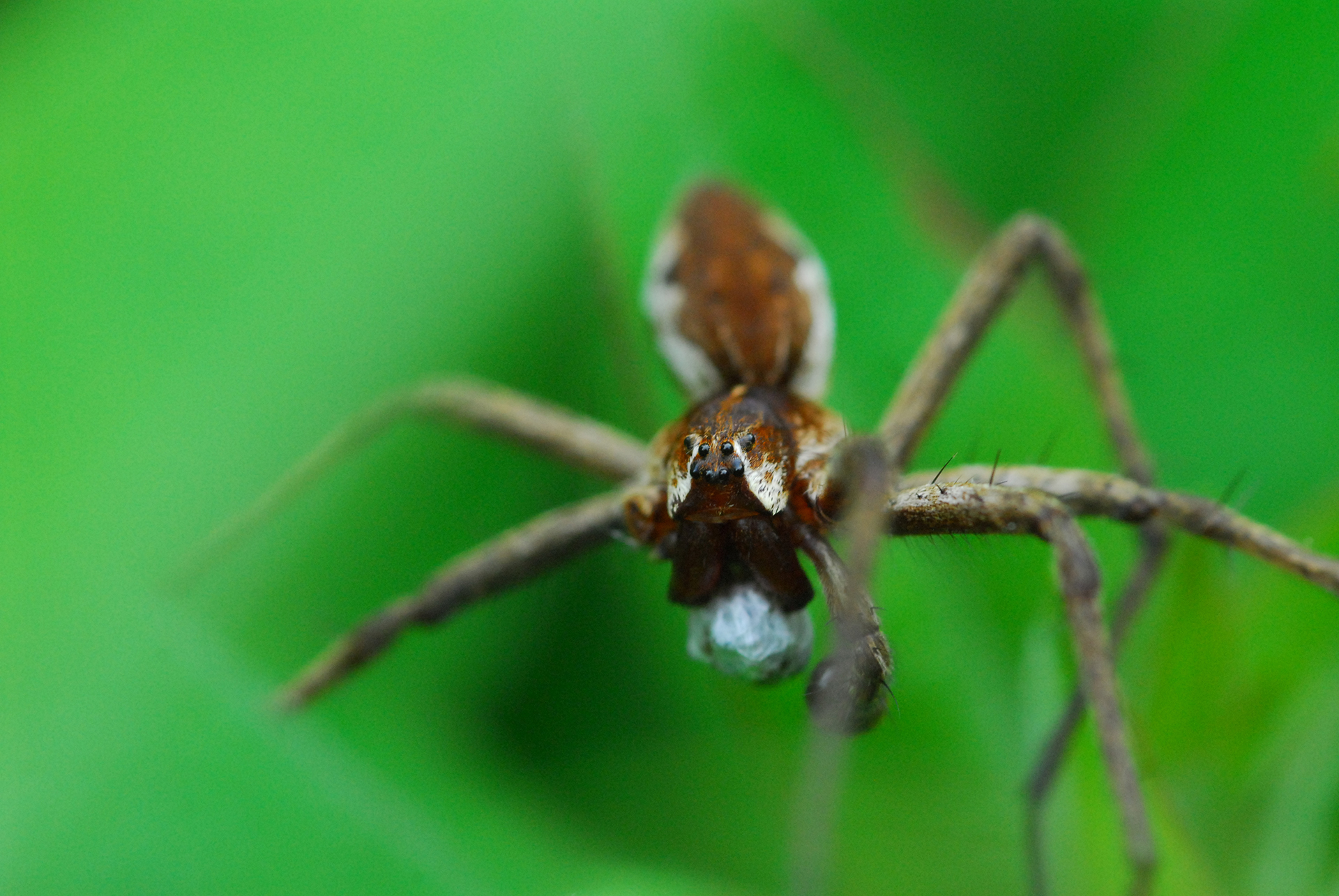
A common spider of heathland and grassland, the Nursery web spider has brown and black stripes running the length of its body. It is an active hunter, only using its silk to create a protective tent for its young.
Statistics
Body length: 1.5cm
The Nursery web spider is a common spider of grassland and scrub, and is often seen sunbathing among Brambles and Stinging Nettles. The adults are active hunters and do not spin a web to catch food, instead using a quick sprint to capture flies and other insects. The female carries her large, round egg-sac in her fangs. When the young are about to hatch, she builds a silk sheet among the vegetation to act as a tent, sheltering them until they are old enough to leave on their own.
Nursery web spider (Pisaura mirabilis)
Web: the Nursery web spider doesn’t make a catching web, but is an active hunter, by using fangs and legs to immobilize prey.
Habitat: often in open habitats with rather high vegetation such as roadsides, grasslands, forest edges. Also in the garden on taller grass.
How to recognize:
- big spider with oblong body
- colour yellow brown to grey brown
- abdomen with variable colour. Often with a light midstripe with dark, undulating bands.
- cephalothorax with a thin, light midstripe, ending in a small tuft of hair.
Looks similar to:
- the Nursery web spider has a very characteristic appearance and is easily recognized
Size
♀: 11-15 mm
♂: 10-13 mm
When?
♀: May till August
♂: May till July
Description
Spiders are insect relatives. These abundant and important predators have eight walking legs, six to eight eyes, and two body regions. The first body segment, called the prosoma, contains the eyes, mouthparts (chelicerae), and legs. The second region is the abdomen, which has spinnerets at its base that produce silk.
Distinctive Features
Nursery web spiders are large hunting spiders that do not spin a traditional web. They are usually brown to tan in color.
Life Cycle
The female carries the egg sac in her fangs and later builds a nursery web before the young hatch. The female will stay near the nursery, perhaps to protect the young from parasites and predators.
Prey
Various insects and other spiders, sometimes small fish.
Habitat
Various species can be found in forests, crawling over plants and trees hunting for prey while others are usually found hunting near aquatic environments, and still others can be found searching for prey in bushes and plants.
Nursery web spiders (Pisauridae) are a family of araneomorph spiders first described by Eugène Simon in 1890. Females of the family are known for building special nursery webs. When their eggs are about to hatch, a female spider builds a tent-like web, places her egg sac inside, and stands guard outside, hence the family’s common name. Like wolf spiders, however, nursery web spiders are roaming hunters that don’t use webs for catching prey.

Species occur throughout the world except for extremely dry or cold environments, and are common just about everywhere. Many can walk on the surface of still bodies of water and may even dive beneath the surface temporarily to escape enemies. They can jump a distance of 5 to 6 inches (130 to 150 mm), but they have trouble climbing extremely smooth surfaces such as glass.
The name “nursery web spider” is especially given to the European species Pisaura mirabilis, but this family also includes fishing spiders and raft spiders. Adult female specimens may reach up to 15mm in length, excluding legs. The legs of the male are longer in relation to body size than those of the female.
The female spider sometimes attempts to eat the male after mating. The male, to reduce the risk of this, often presents the female with a gift such as a fly when approaching in the hope that this will satisfy her hunger. Sometimes, this gift is a fake present intended to fool the female.[3] Males may wrap the fake gift in silk, to deceive the female to mate. Females can detect the fake gift and terminate mating, negating the male’s deception in not giving a real gift.
Nursery web spiders resemble wolf spiders (Lycosidae) except for some key differences. The posterior lateral eyes of wolf spiders are relatively far back and point sideways. In nursery web spiders, the posterior lateral eyes are closer to the posterior median eyes.Also, female nursery web spiders carry their egg sacs with their chelicerae instead of attaching them to their spinnerets as wolf spiders do.
The Nursery Web Spider derives its name from the delicate care a female takes of her egg sac. She gently carries the sac with fangs and builds a web for it in high weeds or low shrubs, suspending it inside of a leaf so it is less visible and more difficult to reach. The female surrounds the sac with layers of silk and then guards this leafy nursery and all her eggs until they hatch. Spiderlings remain in the nursery for about a week after hatching and then head out on their own.
This spider does not spin a web to catch prey. It is an ambush predator and uses its silk for other purposes. Males look slightly different than females, but both genders eat insects and other invertebrates. Look for females among leaf litter and herbaceous plants, carrying a white, golf-ball like sacs. It has a light brown or tan bodies have a darker brown streak running down the middle of the head region and abdomen.
